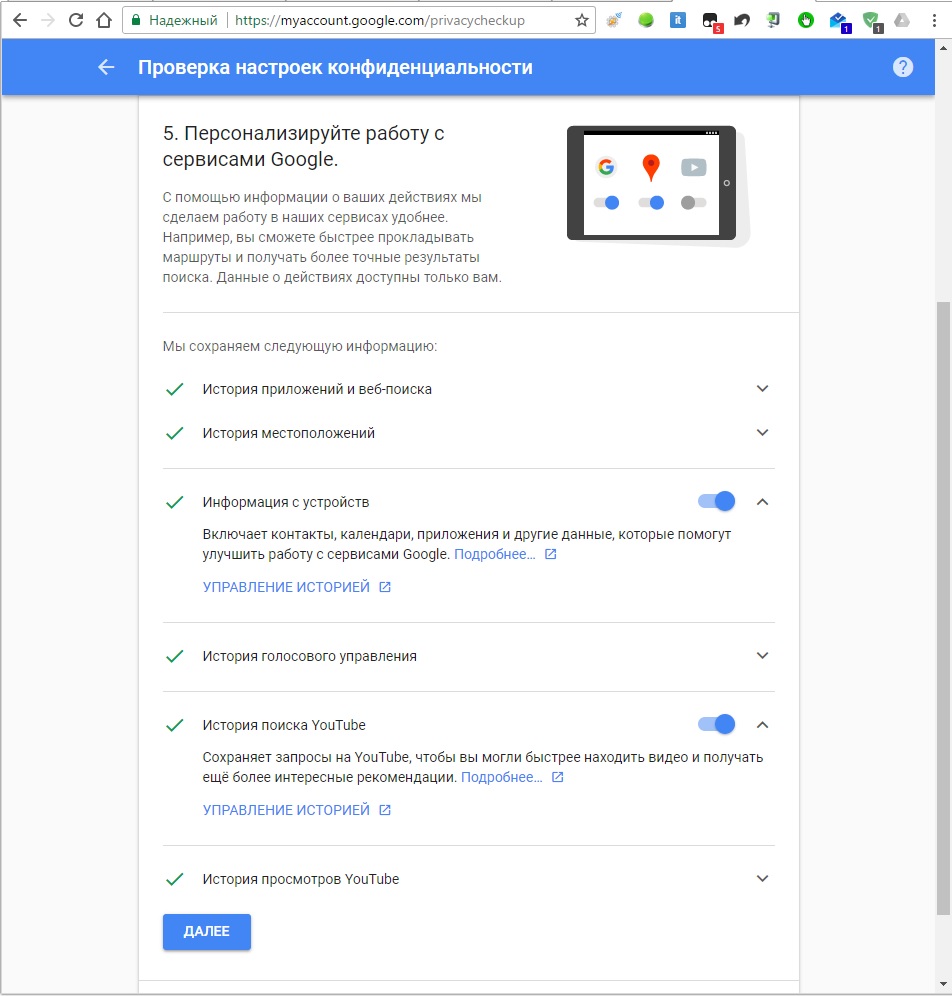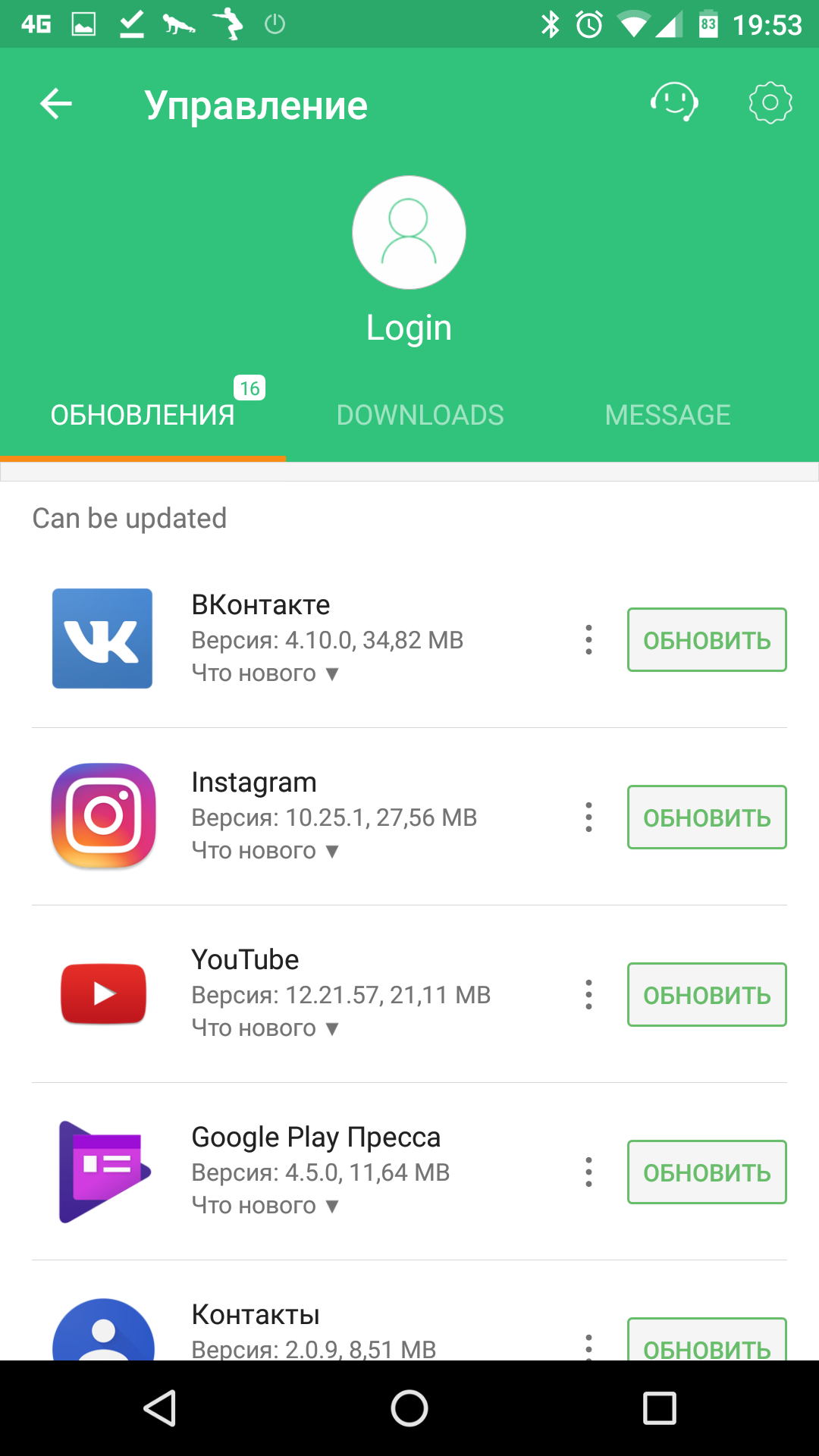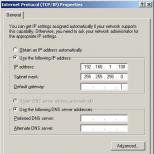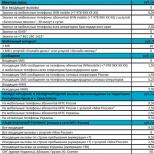Google collects tons of user information using a smartphone. The location, activity of installed applications, contacts, calendar, search history, backup of application data - this is only part of the information that goes to Google’s servers. It’s not necessary to tie a smartphone to a Google account, but then the ability to install applications, synchronize contacts, calendar, backups and many other useful functions in the home will disappear. Can I get around these problems? Let's try to figure it out.
Here are two links that show only a small fraction of what Google knows about you: once, two . Even the most insignificant information gets into the Google logs, up to the records of voice requests to Google Now and Assistant. Officially, the company uses this data to improve products and display targeted advertising. But she also works with law enforcement agencies and upon request will give out as much information about you as you yourself do not know.
Do you want to get rid of surveillance and not lose the usability of your smartphone? Then let's go.
So, when you turn on a new device for the first time or after resetting to factory settings, your smartphone asks for your Google account information and after verification it immediately begins collecting data about your activity. Therefore, there are only three options for circumventing “surveillance”:
The last two actions will disable the synchronization of contacts and photos, deactivate Google Play and application backups. Therefore, you will have to look for workarounds on how to get this functionality back.
So, skipping account binding or installing lightweight firmware, we got a non-working market in the first case or its absence in the second. Accordingly, we need a convenient way to fill the device with the necessary applications. First of all, go to the settings and in the "Security" menu we put a tick (we move the slider) on the item "Unknown sources". This will allow you to install applications not from the Play Store.
After that, you can download and install applications from anywhere, but trust only trusted sources, some of which will be discussed below.
First, learn how to download applications from Google Play. It is not so difficult. You just need to find the necessary program in the browser and then replace play.google.com in the address bar with apk-dl.com. So you will be taken to a page with the ability to download the package.
And - more well-known sites with similar, but enhanced functionality. APKMirror is a favorite file sharing site for Android Police. The download page contains the package name, version number, minimum requirements for the Android version. Previous versions of applications are available for download, and the main page contains a feed of the latest downloads, as well as statistics of the most popular applications based on downloads for 24 hours, seven days and a month.
APKPure has a brighter design with a main page advertising mainly games. The site also allows you to download previous versions of applications.
It should be borne in mind that both of these sites do not distribute warez, which means that only free software can be downloaded through them.
Another advantage of apkpure.com is its convenient client. After starting, it scans the installed applications and displays a notification in the curtain, offering to update them to the current versions.
Google collects tons of user information using a smartphone. The location, activity of installed applications, contacts, calendars, history of search queries, backup of application data - this is only part of the information that goes to Google servers. Linking a smartphone to a Google account is not necessary at all, but then the ability to install applications, synchronize contacts, calendar, backups and many other useful functions in the home will disappear. Can I get around these problems? Let's try to figure it out. The vast majority of this is software produced by Google. And it's no secret that the main business of google is the collection of our private information. Google tirelessly collects information about us, search queries are carefully logged, movements are tracked, and passwords, letters and contact information are stored for years to come. All this is an integral part of modernity, but we may well change it.
Today I will tell you how to remove google programs from your phone, replacing them with open-source counterparts and thereby significantly increase your privacy.
It's no secret that any Android device (at least that certified by Google) contains not only components assembled from AOSP, but also an impressive number of Google proprietary programs. These are the very Google Play, Gmail, Hangouts, Maps and a bunch of other applications, including a dialer and a camera (starting with KitKat).
For all these components, there is not only the source code, but generally no explanation about the principles of their work. Many of them were originally created with the aim of collecting certain types of information and sending them to Google servers. For example, GoogleBackupTransport, which is responsible for synchronizing the list of installed applications, passwords and other data, GoogleContactsSyncAdapter, which synchronizes the contact list, or ChromeBookmarksSyncAdapter, whose job is to synchronize browser bookmarks, behave. Plus, collecting information about all queries in the search engine.
There is nothing wrong with the fact of synchronization, of course, and this is an excellent mechanism that allows you to set up a new phone in minutes, and Google Now even manages to give us useful information based on our data (sometimes). The only problem is that all this destroys our privacy, because, as Snowden showed, under the hood of the NSA (and, most likely, of a bunch of other services) is not only some evil empire called Microsoft, but also Google, and also many other companies from the party "we are not evil, but furry patrons."
In other words: Google will merge us all without any problems, and it’s not a fact that its employees, sitting in their offices with masseuses and dogs, do not laugh at the names from your contact book (everything is encrypted there, yes) while drinking 15-year-old puer from Yunnan. Or maybe to hell with Google? Take them Android, and let them go the forest themselves?
What are Google Apps?
The latest version of custom firmware based on KitKat for my smartphone weighs 200 MB, however, in order to get real experience from the smartphone, I must also flash the gapps archive on top of it, which is 170 MB in size. Only after that I will get a system similar to that preinstalled on Nexus devices, with all the goodies in the form of a desktop integrated with Google Now, a screen lock based on a face shot, a camera with support for spherical shooting and kilograms of Google software, starting from Google Play and ending with Google Books
I repeat once again: all this is closed software from Google, which in a good way cannot be distributed at all without their knowledge (therefore, it is not available in custom firmware such as CyanogenMod), but since extracting it from the firmware of Nexus devices is quite simple, you can find it on the Web a huge number of such archives, including heavily stripped down ones. In order to release an Android smartphone with a set of gapps on board, the manufacturer must send it for certification to Google, which, evaluating the quality and performance of the smartphone, will either give the go-ahead or otfootball (but this does not stop the Chinese at all).
So Google Apps get to the smartphone. Of the users, 99% either use preinstalled applications, or install them independently on a completely clean and completely anonymous firmware. And then from the moment you enter the username and password, synchronization and drain of information begins.
To understand how this happens, unpack the same archive with gapps and take a look inside. We are interested in the / system / app and / system / priv-app directories, when installed, their contents are copied to the same directories inside the smartphone. The second directory is KitKat innovation, which was thought up, apparently, for storing private applications that are accessible only to the administrator (owner) of the device and are invisible to other users wired up in the system.
In the / system / app directory we will find a large number of different Google applications that are easily recognizable by the package name: Books.apk, Chrome.apk, Gmail2.apk and so on. Each of them will share information in its own way, but this is absolutely normal (yes, Google will know that you are reading Paulo Coelho through their application!). The greatest danger here is GoogleContactsSyncAdapter.apk, which is only responsible for sending contact lists to a remote server. We write the name in a notebook and move on.
Most of the files in the / system / priv-app directory are the services and frameworks needed to run this whole sync engine and snooping:
- GoogleBackupTransport.apk - deals with the synchronization of installed application data, Wi-Fi passwords and some settings;
- GoogleLoginService.apk - associates a device with a Google account;
- GooglePartnerSetup.apk - allows third-party applications to access Google services;
- GoogleServicesFramwork.apk - a framework with various utility functionality;
- Phonesky.apk - Play Store (oddly enough);
- PrebuiltGmsCore.apk - Google Services, as the name implies, is the core of the entire gapps suite;
- Velvet.apk - a search from Google, which includes a search bar on the desktop and Google Now.
In essence, this is the part of Google Apps that is responsible for draining our private information. Let's try to get rid of all this. Method number 1. Shutdown through settings
The easiest way to untie your smartphone from Google is to use the standard system settings. The method is good in that it does not require root privileges, nor the installation of custom firmware, nor custom recovery. Everything can be done in any stock firmware without losing access to your account and applications like Gmail (if necessary). However, no one will vouch for efficiency, since it is quite possible that some gapps components will continue to send data.
The main location for synchronization settings is the menu “Settings -\u003e Accounts -\u003e Google -\u003e [email protected] ". Here you can turn off things such as synchronizing contacts, application data, Gmail, Play Music, Google Keep, and more. All you need to do is just to uncheck the necessary menu items. Next, go to the menu "Settings -\u003e Restore and Reset" and remove the daws from the items "Data Backup" and "Auto Recovery".
The Google Settings application, which is part of Google Services, is also responsible for many synchronization settings. Using it, in particular, you can disable Google’s access to a location ("Access to geodata -\u003e Access to my geodata / Send geodata / Location history"), disable sending personal data to a search engine ("Search -\u003e Personal data"), disable Google Now (“Search -\u003e Google Now”) and disable remote control (“Remote control -\u003e Remote device search / Remote lock and reset”).
In the same "Google Settings", by the way, you can disable any application that uses a Google account for authorization. This is not only about the software installed on the device, but also about all the ever used applications, including websites. For example, I found in this list a lot of sites that I have not visited for at least a couple of years.
In the event that you are not going to use Google services at all, it will be easier to disconnect the smartphone from the account completely, that is, simply delete it through the settings: “Settings -\u003e Accounts -\u003e Google -\u003e [email protected] -\u003e Menu Button -\u003e Delete Account. "
Most Google applications can be safely disabled through the settings: "Applications -\u003e ALL -\u003e the desired application -\u003e Disable."


Method number 2. Cleaning the official firmware.
In the event that the stock firmware has root rights, you can get rid of Google Apps by simply deleting them from your smartphone. As I said, all of them are stored in the directories / system / app and / system / priv-app. For example, in the case of KitKat, the list of Google applications in the first directory would be:
- Books.apk - Google Books;
- CalendarGoogle.apk - Google Calendar;
- Chrome.apk - Google Chrome;
- CloudPrint.apk - a cloud printing system;
- Drive.apk - Google Drive;
- GenieWidget.apk - news and weather widget;
- Gmail2.apk - Gmail;
- GoogleContactsSyncAdapter.apk - contact synchronization;
- GoogleEars.apk - Google Ears (similar to Shazam);
- GoogleEarth.apk - Google Earth;
- GoogleHome.apk - home screen with integrated Google Now;
- GoogleTTS.apk - speech synthesis system;
- Hangouts.apk - Google Hangouts
- Keep.apk - Google Keep;
- LatinImeGoogle.apk - keyboard with gesture support;
- Magazines.apk - Google Magazines;
- Maps.apk - Google Maps;
- Music2.apk - Google Music
- PlayGames.apk - Google PlayGames;
- PlusOne.apk - Google+;
- QuickOffice.apk - QuickOffice;
- Street.apk - Google Street
- SunBeam.apk - SunBeam live wallpapers;
- Videos.apk - Google Movies
- YouTube.apk - YouTube.
In the / system / priv-app directory, in addition to the ones listed above, the following files are also stored: - CalendarProvider.apk - stores calendar data;
- GoogleFeedback.apk - sends a report on the use of Google Play;
- GoogleOneTimeInitilalizer.apk - installation wizard for additional Google applications;
- SetupWizard.apk - setup wizard on first run;
- Wallet.apk - Google Wallet
- talkback.apk - voice notification of events on the device.
The Gapps kit for KitKat, among other things, also includes a proprietary camera with support for spherical shooting and a proprietary desktop with integrated Google Now.
But that is not all. Google Apps depends on several frameworks located in the / system / framework directory. These are com.google.android.maps.jar, com.google.android.media.effects.jar and com.google.widevine.software.drm.jar files. There are many libraries in the / system / lib directory that are used exclusively by Google applications. Removing them is not necessary, but possible. Just to clear the trash. You will find their list on in comments. In previous (and future) versions of the system, the content of Google Apps is different, therefore, before uninstalling, I recommend downloading the gapps of the correct version from goo.im/gapps, unpack using WinRar and view the contents. You should also take into account the dependence of some applications from the market on Google applications, I will talk more about this later.

Method number 3. Custom firmware without gapps
The previous method can be greatly simplified if you just install custom firmware on your smartphone without Google Apps. In this case, the smartphone / tablet will be crystal clear without any connection to Google. The disadvantage of this method is the lack of Google Play, but you can either replace it with a third-party application store (see below) or use the following method, which includes installing a truncated version of Google Apps.
Method number 4. Google Play and nothing but
This method of partial decoupling from Google is a kind of compromise. It does not solve the problem of surveillance - at least without the settings from the first method - but allows you not to litter the system with a bunch of useless software that will hang in the background and eat memory. The bottom line is simple - we install custom firmware and fill it with a minimalistic version of gapps, which includes only Google Play.
There are many such minimal assemblies of gapps on the Web, but I would recommend using the time-tested BaNkS Gapps, namely the “month-number GAppsCore4.4.2signed.zip” file. They work on any smartphone, are compatible with ART and include only the main gapps files, a list of which is given in the What are Gapps section, framework files, as well as several libraries. In essence, these are Google Play, synchronization tools and nothing more.
Change the search engine to DuckDuckGo
Even after the synchronization is completely turned off, the “built-in” Google search bar will remain on the home screen. In the stock firmware of some manufacturers (Samsung, for example), this is just a widget that can be easily removed from the screen. In pure Android and devices from many other manufacturers, it is “sewn” into the home screen, but it can be removed by disabling all search from Google (along with Google Now) using the menu “Settings -\u003e Applications -\u003e All -\u003e Google Search -\u003e Disable ”or by installing a third-party launcher. Next, just download DuckDuckGo from the market or another app store and add the widget of the same name to the home screen.
Third-party market
The second and third methods involve the complete elimination of Google Apps, including Google Play and the ability to login using a Google account, so we must find a way to easily and conveniently install applications that would not force us to download them ourselves, and then drop them onto a memory card and install manually. One of such ways is to establish a third-party market.
There are currently three more or less viable alternatives to Google Play. These are Amazon Appstore, Yandex.Store and 1Mobile Market. Each of them has its own advantages and disadvantages, which mainly boil down to the number of applications and payment methods:
- Amazon appstore
- The most famous app store after Google Play. It contains more than 75 thousand applications (compared with 800 thousand on Google Play), the quality of each of which is checked manually, just like in iTunes for iOS. You can pay with a credit card or Amazonian coins (Amazon Coins), which are given as a gift for buying a Kindle Fire tablet or as a gift from another user. One of the most interesting features of the store is the daily free distribution of one of the paid applications.
- Yandex.Store
- a store from the Yandex company. It contains more than 85 thousand applications, each of which is scanned by Kaspersky Anti-Virus. It doesn’t stand out much, but it has a killer feature in the form of the ability to pay for purchases using the Yandex.Money service or a mobile phone account.
- 1Mobile Market
- The largest third-party repository of Android applications, which includes more than 500 thousand software. It differs from others in the presence of exclusively free applications (not to be confused with pirated ones), which allows it not to go through the stage of registering an account and maintain anonymity.
Applications in all three markets have original digital signatures of application developers, which allows you to use them simultaneously. An application installed from one market can be updated without problems from another, and upon removal it will disappear from the list of installed at once in all. True, you will have to buy separately.



Open Source Market
In addition to those described in the article, as well as many other less well-known application stores, on the Web you can find a different F-Droid repository. It is completely anonymous and contains only free software distributed under licenses approved by the FSF. There are only a thousand applications in F-Droid, but all of them are guaranteed to not contain backdoors and other systems for the disclosure of personal data. It is F-Droid that is used as the default market in the free Android firmware Replicant.

Resolving Google Apps Application Dependence
Despite the fact that gapps components are not part of the official Android API, some applications still expect to see them in the system, which can cause a number of problems - from the complete inoperability of the application to the loss of some of its functions. Some applications will refuse to install due to the lack of the Google Maps API, others will crash immediately after launch, not detecting it, while others include direct links to Google Play, which can lead to crashes and incorrect operation.
To solve these problems, the MaR-V-iN user with XDA launched the NOGAPPS project, which is developing a set of open components that replace the original functionality of Google Apps. Three replacement components are currently available:
- Network location - Geolocation service based on Wi-Fi and GSM base stations. Based on Apple's IP address database and open base station database;
- Maps API - replacement of the interface to Google Maps based on OpenStreetMap;
- Blankstore - An open alternative to the Play Store customer. It allows you to install free applications from the Google store, but it is not recommended for use due to possible sanctions by the search engine (this is prohibited by their rules).
Components are installed separately and in various ways. It is enough to manually copy the Network Location to the / system / app / directory in Android 2.3–4.3 or to the / system / priv-app / directory in KitKat (in this case, use the NetworkLocation-gms.apk file). The Maps API is installed using the nogapps-maps.zip file firmware via the recovery console. To install the market, you will have to not only copy the file, but also generate an Android ID on a large machine. After all the manipulations, the software should work correctly.
conclusions
For Google, Android without its own applications is useless, so there is nothing surprising in the fact that the company takes out the most delicious parts of the system and leaves the code closed. However, in this article I showed that there is life without gapps and it can be even simpler and more convenient than with Google.
YouTube.com is the most famous video hosting and the third most popular website in the world. He achieved such successes thanks to convenience and simplicity. Using YouTube You can watch the most popular videos from around the world - from hot music news to the latest news, and you can also add video clips on www.youtube.com. "YouTube" will help you have a great time and have fun, it will be available anytime, anywhere. The decor is made in dark red colors.
YouTube for Android has several unique features that set the app apart from its competitors. Firstly, this is the ability to preload when the phone is connected to a Wi-Fi network, the application will download the video and save it to the cache, so you can easily view it with a slow connection. Secondly, the ability to connect a smartphone to a TV, and broadcast video on a large screen.

















